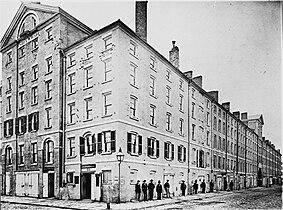India Wharf

India Wharf (1804-c. 1962) in Boston, Massachusetts, flourished in the 19th century, when it was one of the largest commercial wharves in the port. The structure began in 1804 to accommodate international trade at a time when several other improvements to the Boston waterfront occurred, such as the creation of Broad Street and India Street.[1]
History[]
Funders and organizers of the construction of India Wharf in 1803 on the waterfront near Long Wharf included Francis Cabot Lowell, Uriah Cotting, Henry Jackson, James Lloyd Jr., and Harrison Gray Otis.[2][3] Builders completed the wharf in 1804. Architect Charles Bulfinch designed the building atop the wharf, completed in 1807.[4] The long stone building housed 32 stores.[2] An observer in 1815 described: "Across from the long wharves, or in the western part of the city, the India Wharf runs from north to south. An immense stone store, 1,340 feet in length, is divided into rooms containing merchandise from the East Indies...."[5]
Merchants operating from India Wharf included China traders Russell and Company (1824);[4] Samuel Austin, Jr.; James Carter; J.T. Coolidge; Samuel Devens; Thomas Dixon; Francis Ellis; Thomas and Edward Motley; Henry Oxnard; John Pratt & Son; Robert B. Storer; Thwing & Perkins.[6] Also on the wharf were grocers Edward Keays and John Worster; cooper John Lang; broker Joseph Hall; iron dealers Perrin & Ellis; painter Jacob Thaxter; hairdresser Lewis Johnson.[6] Other firms included "Thomas Wigglesworth; W.F. Cunningham & Co.; George T. Lyman; Bullard & Lee; the Higginsons;... W. Windsor Fay; E.A. Homer; B. Burgess; Minot & Hooper; Boardman & Pope; all well-known merchants of their day. ...Here also were the consulates of Sweden, Norway, Belgium, and Russia."[7] The Norris and Baxter dining saloon maintained a presence on the wharf, c. 1857.[4]
Through the mid-19th century, India Wharf became Boston's "headquarters of the trade with the Orient and many valuable cargoes from Canton, Calcutta, Russia and the Mediterranean ports were discharged there. ...There were 30 stores in the block. Many Bostonians of today can recall the time when several large square riggers were moored at the wharf, unloading their cargoes of tea, coffee, spices and fruit."[3] Shipping activity continued on the wharf into the 20th century.
Demolition of the wharf and the long building occurred in stages, c. 1868-1962. Since 1971, the brutalist high-rise Harbor Towers have occupied the former site of India Wharf.[2][4][8]
Images[]

Detail of 1814 map of Boston, showing India Wharf and vicinity

India Wharf, Boston, 19th century

Overview of wharves, 1870 (India Wharf 3rd from left)

India Wharf, Boston, 1935

Harbor Towers, on former site of India Wharf, 2010
See also[]
- Maritime Fur Trade
References[]
- ^ Walter M. Whitehill (1959), Boston, a topographical history, Cambridge, Mass: Belknap Press of Harvard University Press, OL 23799175M
- ^ a b c Nancy S. Seasholes (2003), Gaining Ground: a history of landmaking in Boston, Cambridge, MA: MIT Press, ISBN 0262194945, 0262194945
- ^ a b Albert W. Mann (1917), Walks & talks about historic Boston, Boston, Mass: The Mann publishing co., OCLC 2503581, OL 6602002M
- ^ a b c d Jim Vrabel (2004), When in Boston: a time line & almanac, Boston: Northeastern University Press, ISBN 1555536212, OL 3290630M, 1555536212
- ^ Jacques Gerard Milbert, quoted in: Constance D. Sherman (1959). "Boston from the State House Belvedere a Century Ago". The New England Quarterly. 32 (4).
- ^ a b Boston Directory. Boston: Stimpson & Clapp. 1832. Retrieved 12 August 2009.
- ^ State Street Trust Company (Boston, Mass.) (1918), Some merchants and sea captains of old Boston: being a collection of sketches of notable men and mercantile houses prominent during the early half of the nineteenth century in the commerce and shipping of Boston, Boston: State Street Trust Co., OCLC 2601692, OL 6614255M
- ^ India Wharf is 100 years old. Boston Daily Globe. March 13, 1910. p.53.
Further reading[]
- Improvements at India Wharf: New Lease of Business Life of the Old Boston and Portland and Metropolitan Lines. Boston Daily Globe. July 12, 1882. p. 3.
- Sailor's body evidently: Picked Up in the Dock at India Wharf, ... Mangled. Boston Daily Globe. April 22, 1901. p. 2.
- Not for her: Lucky Penny Brought No Good Fortune. One of the Few Things Found in Miss Cahill's Pocket. She Committed Suicide Wednesday Night. Body Found Yesterday Off India Wharf. Owed Her Landlady and Had Been Out of Work. Out of Work. Highly Spoken Of. Boston Daily Globe. June 7, 1901. p. 6.
- Five rounded up: Italians and Others in a Fight on India Wharf—Stinson Cut—Some Had Revolvers. Boston Daily Globe. June 5, 1906. p. 6.
- Samuel Eliot Morison (1921), The maritime history of Massachusetts, 1783-1860, Boston: Houghton Mifflin, OL 7243372M
- Last tribute paid to 176 lost on ship: kin of those on the Portland in 1898 cast flowers from India Wharf in Boston. New York Times. Nov 27, 1948. p. 28.
- 5-Alarm Fire Sweeps Boston's Historic India Wharf. New York Times. March 4, 1955. p. 16.
External links[]
| Wikimedia Commons has media related to India Wharf, Boston. |
- Historic American Buildings Survey, Library of Congress. India Wharf Stores, 306-308 Atlantic Avenue, Boston, Suffolk, MA
Coordinates: 42°21′28.25″N 71°3′0.62″W / 42.3578472°N 71.0501722°W
- Transport infrastructure completed in 1804
- Commercial buildings completed in 1807
- Wharves of Boston
- Boston Harbor
- Former buildings and structures in Boston
- Economic history of Boston
- Financial District, Boston
- 19th century in Boston
- Charles Bulfinch buildings





